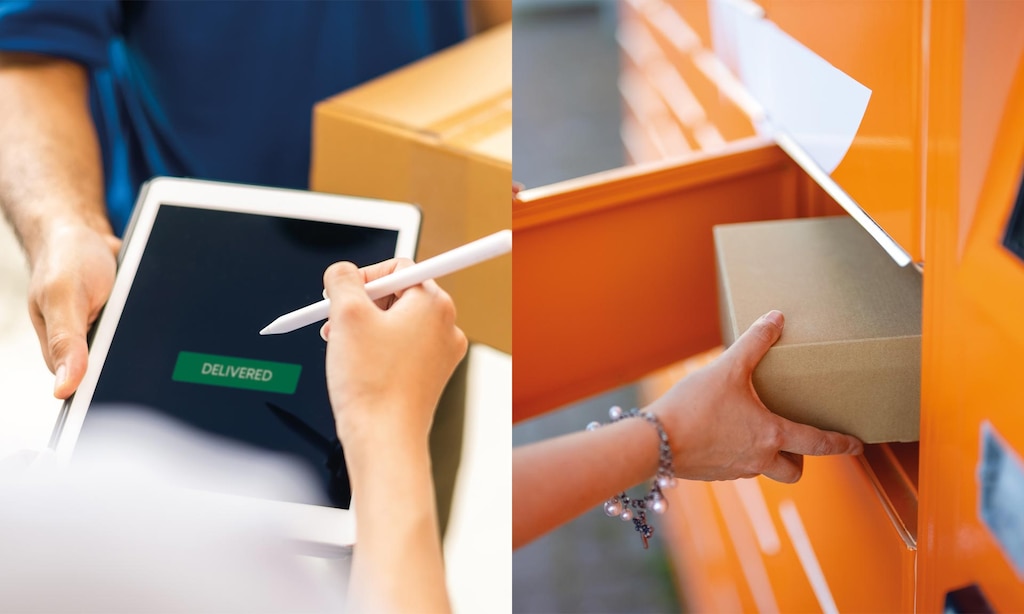
LOGISTICS RESEARCH
By Alinda Kokkinou, Hans Quak, Ondrej Mitas, and Albert Mandemakers
Technological developments such as the broadening availability of connectivity and mobile devices have led to an increase in e-commerce, especially in online business-to-consumer (B2C) sales. This growth has been fueled by online companies as well as traditional retailers investing in multichannel and omnichannel models. As a result, logistic service providers (LSPs) are now required to cater to individual consumers. These customers have heightened expectations and generate geographically dispersed small orders. This has led to increased freight movements, largely in the last mile.
The cost and environmental impact of last-mile delivery can be minimized from both the supply and demand sides. For example, LSPs have turned to the use of electric vehicles to reduce emissions. However, consolidation of parcels can only be achieved if recipients are incentivized to choose certain delivery options at check-out. This motivation can be extrinsic or intrinsic.
Commonly used extrinsic incentives are price surcharges for next-day delivery or price discounts for selecting a longer time window. Nevertheless, this price partitioning can be perceived as unfair. Furthermore, online shoppers are used to what they understand to be “free” deliveries and clearly prefer them. Although incentives based on consumers’ intrinsic motivation and values could be an alternative, delivery price remains a crucial issue.
Customers like to receive their parcels within a day, without having to pay for delivery. So, while financial motivation appears to be the most effective way to steer them toward more sustainable delivery options, it carries the risk of negatively affecting the shopping experience.
Order consolidation
One way to increase productivity and reduce road transportation is order consolidation. This practice involves grouping together as many deliveries as possible. Two widespread solutions based on this logistics principle are delaying deliveries (allowing LSPs to optimize routing and vehicle capacity) and delivering parcels to a locker or pick-up point.
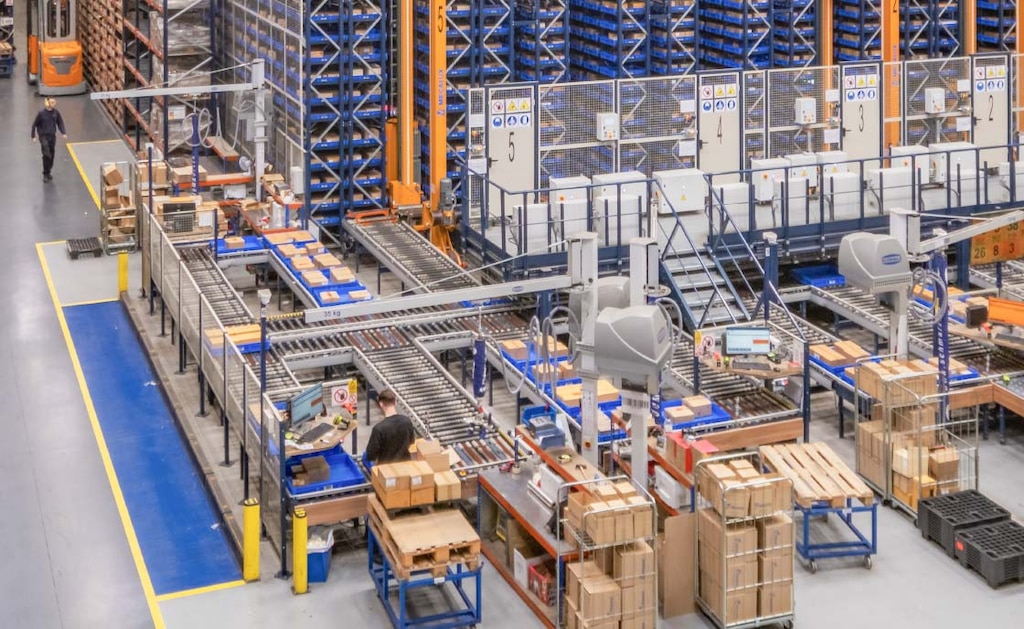
When pick-up and delivery points are located far from residential areas, customers are more likely to pick their parcels up by car, reducing the benefits of consolidation. Sustainability improves when customers make these trips by bike or on foot. For the purpose of our study, we considered home delivery to be less environmentally sustainable than options based on the consolidation principle. In line with on this premise, we investigated the following research question: How can customers be stimulated to choose a more sustainable parcel delivery option?
Perceived user satisfaction
Two mechanisms explain how information available to customers prior to purchase can affect their post-purchase satisfaction: the disconfirmation paradigm and the concept of perceived value. According to the disconfirmation paradigm, customer (dis)satisfaction occurs when customers’ pre-purchase expectations are (not) met. In the context of e-commerce, overall customer satisfaction is affected by retailer-related factors (e.g. product quality) and LSP-related factors such as perception of the fulfillment process and even interaction with the delivery driver. Aspects like price and timeliness of delivery also affect the overall experience.
Similarly, users perceive value when a service is tailored to their needs. To compete with brick-and-mortar stores, online retailers often promise next-day delivery at no additional cost even though customers seem to be willing to wait once informed of the sustainability benefits. So, what impact does offering delivery options with different prices and timelines have on overall satisfaction?
Incentivizing sustainable delivery in the purchasing process
There are several ways to encourage customers to choose one option over another. These include the order in which the options are presented and making the greener alternative the default one. These incentives rely on the principle of nudging, which seeks to create the conditions or environment in which the socially desirable course of action requires less effort. Another way to nudge consumers is to create social pressure. This has been investigated by giving customers the option to share their choice of sustainable delivery on social media.
An important factor affecting whether consumers will engage in a desired behavior is their knowledge. Being aware of the situation is a prerequisite for the intention to behave ecologically. In the context of last-mile delivery, it may be effective to inform customers about the sustainability of each option.
Preference analysis: a pair of sneakers
To answer our research questions and test our hypotheses, we conducted two experiments. Each focused on choosing between next-day home delivery and a more sustainable method. In Survey 1, customers could wait longer for delivery. In Survey 2, they could retrieve their parcels from a locker or pick-up point. Each survey was presented to a different group of students at a University of Applied Sciences in the Netherlands.
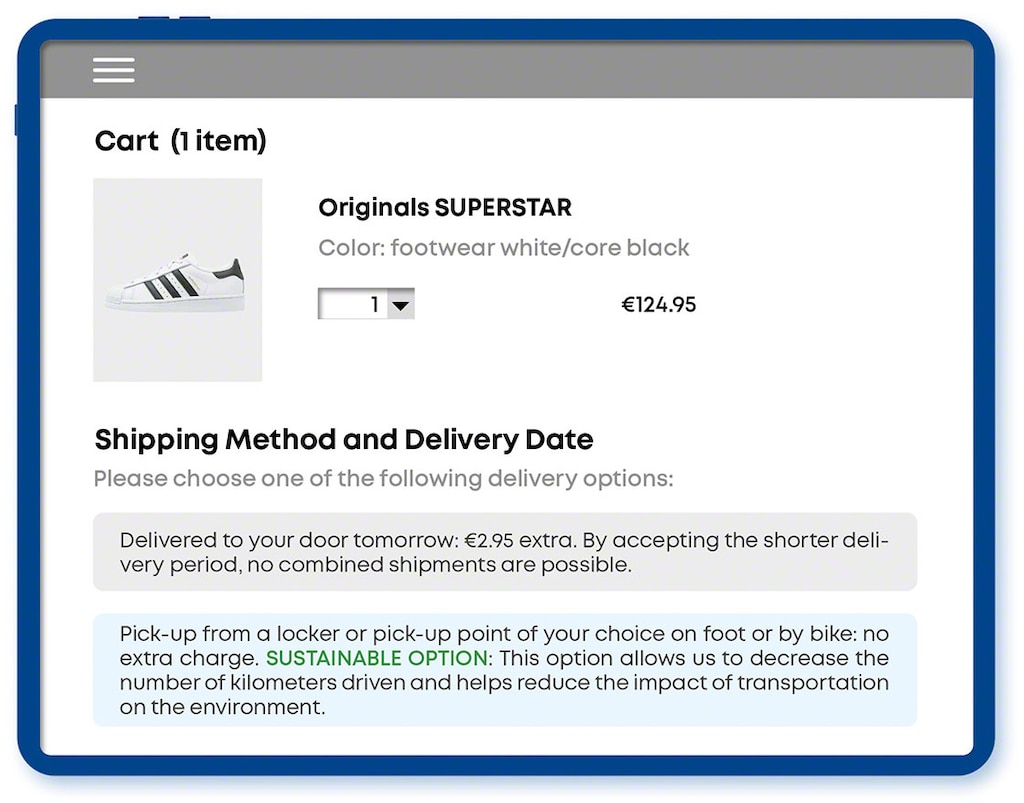
Sample experimental scenario (Survey 2, Condition 8, Price: high, Information about sustainability: yes, Surcharge: yes)
Both experiments were administered by means of a survey. Participants were shown a shopping cart with two delivery options: home delivery and the more sustainable alternative. Next, they were asked about their satisfaction with the types of delivery offered. Then, the participants responded to questions about their attitude toward the environment according to a scale. The final section included demographic questions.
Eight different shopping carts were designed, and participants were shown one randomly. All carts had a single product: a pair of sneakers. We chose them for our study because they could realistically be picked up at a locker or pick-up point. Additionally, it was possible to vary their prices.
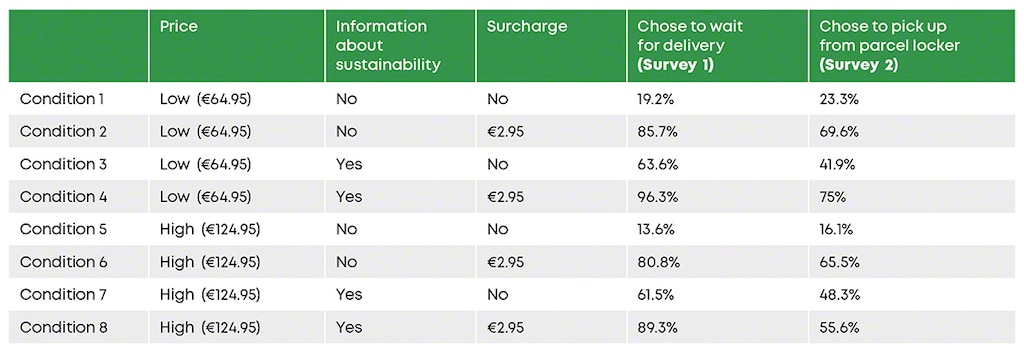
Experimental conditions and proportion of respondents who chose the sustainable alternative
Results
Survey 1: Delayed delivery
- The study revealed that, holding all other predictor variables constant, respondents were 18.51 times more likely to choose the more sustainable alternative (namely waiting for up to three days) if they had to pay a surcharge for next-day delivery.
- Similarly, the odds of respondents selecting the more environmentally friendly alternative increased 6.51 times when they received information about the sustainability of the delivery.
- Furthermore, the probability of respondents preferring the greener choice rose by 73% for each additional point on the attitude toward the environment scale.
Survey 2: Parcel locker or pick-up point
- In this second scenario, with all other predictor variables constant, the odds of customers selecting the sustainable option were 3.3 times higher if they were shown a surcharge for next-day delivery.
- For each additional point on the attitude toward the environment scale, the probability of customers choosing the greener option increased by 48%. This variable rose by 62% for each additional increment of familiarity with parcel lockers.
- Applying a surcharge for next-day delivery had a significant negative impact on satisfaction with delivery options.
Ultimately, we found that charging customers for next-day delivery was the most effective way to stimulate them to choose the more sustainable option. Customers were 18 times more likely to be willing to wait for delivery and 3.3 times more likely to pick their parcel up themselves at a locker or designated point.
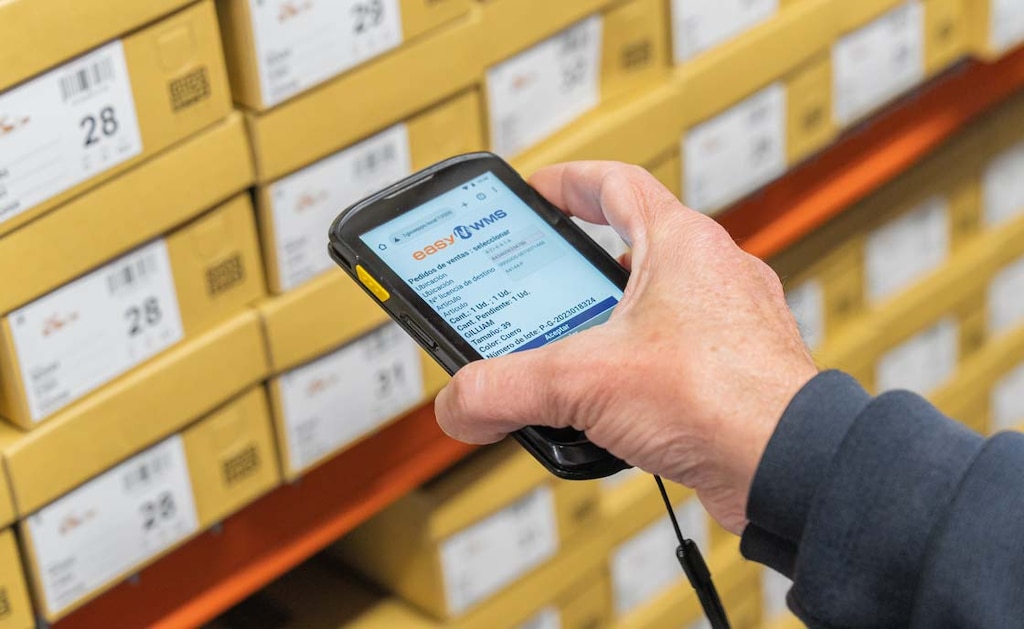
Effects on customer satisfaction
Our findings show that extrinsic motivation in the form of financial incentives remains an important tool for steering consumers toward more sustainable alternatives. Although charging customers for next-day delivery led to a small but significant decrease in satisfaction, retailers should not systematically dismiss these incentives. Instead, ways to make this strategy more acceptable to consumers should be investigated. The literature on price fairness suggests that if customers understand the motivations behind a delivery surcharge, they may accept it as fair.
Last-mile deliveries can cause problems in urban areas requiring solutions to reduce external costs such as traffic congestion and pollution. From this perspective, applying additional fees can be considered to a large extent a governmental responsibility. The effects of surcharges can be mitigated if all LSPs and/or retailers have to engage in the practice concurrently. As a result, transportation pricing could be a governmental instrument for establishing a level playing field and fair competition.
Finally, the results of our study can contribute toward decision-making on urban planning and the utilization of urban space for e-commerce activities. Both parcel lockers and pick-up points must be accessible to consumers by bike or on foot to be considered a sustainable alternative.
AUTHORS OF THE RESEARCH:
- ALINDA KOKKINOU. Researcher and Lecturer, Breda University of Applied Sciences and AVANS University of Applied Sciences (Netherlands).
- HANS QUAK. Professor of Smart Cities and Logistics, Breda University of Applied Sciences; Senior Scientist, TNO (Netherlands).
- ONDREJ MITAS. Professor, Academy for Tourism, Breda University of Applied Sciences (Netherlands).
- ALBERT MANDEMAKERS. Professor, Department of Built Environment & Logistics, Academy for Tourism, Breda University of Applied Sciences (Netherlands).
Original publication:
Kokkinou, Alinda, Quak, Hans, Mitas, Ondrej, Mandemakers, Albert. 2024. “Should I wait or should I go? Encouraging customers to make the more sustainable delivery choice.” Research in Transportation Economics (Elsevier).
© 2023 The Authors. Licensed under CC BY 4.0
